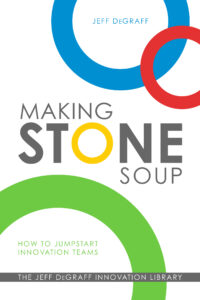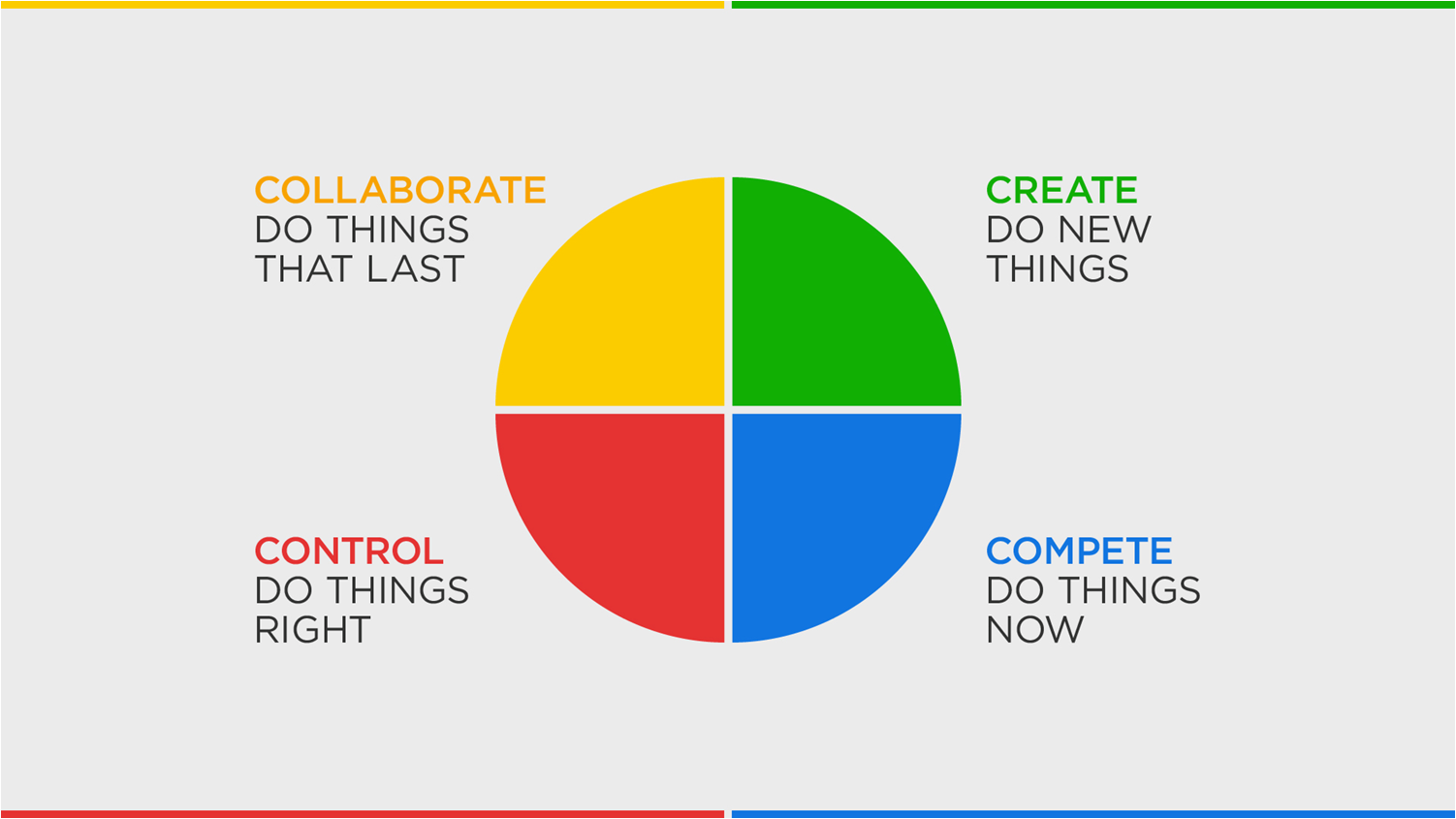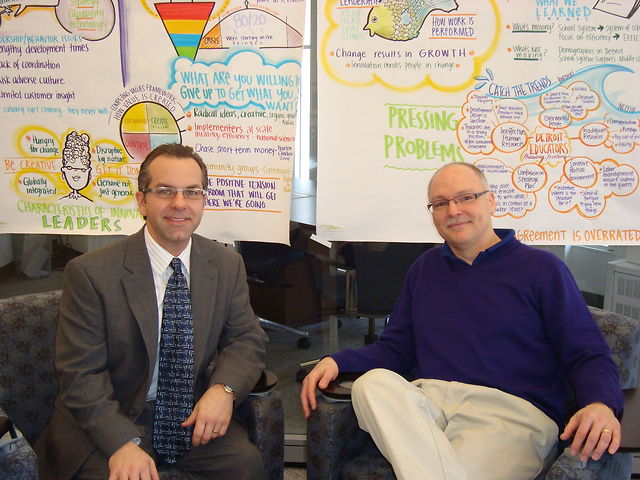Is your team stuck and in need of an innovation injection?
Are there ways to structure brainstorming to enhance the creative process?
Is it possible to learn how to innovate and create?
Make Stone Soup
If you study innovation, creativity and success, you will likely know my friend Jeff DeGraff. I first met him when I was running a business in Ann Arbor, Michigan. Someone on my team introduced me to the “Dean of Innovation” when we were struggling with a problem. Dr. DeGraff is a professor at the Ross School of Business at the University of Michigan. He has worked with some of the biggest global corporations including Apple, Visa, GE, Coca-Cola, and Johnson & Johnson.
His most recent book is Making Stone Soup: How to Jumpstart Innovation Teams. If you want the recipe for collaborative innovation, this colorful book will deliver while inspiring you with new ideas for your team.
Misconceptions About Innovation
Most of us think of innovation and think of a brilliant inventor, solitarily working when Eureka! Bam! Innovation strikes! You say most innovation doesn’t happen in that manner but, instead, happens in teams. Tell us more about that.
Any other common misconceptions about innovation?
Most people have a very limited concept of innovation. They think it’s a g adget or an electric powered vehicle. But these technological inventions are the very end of the innovation chain. What makes your smart phone light and compact has more do with breakthroughs in material science than it does creative design thinking. More so, innovations are often services or integrated solutions such as Google’s business model. Innovation is by definition a type of deviance from the norm, and therefore what makes an innovation is constantly morphing and progressing.
adget or an electric powered vehicle. But these technological inventions are the very end of the innovation chain. What makes your smart phone light and compact has more do with breakthroughs in material science than it does creative design thinking. More so, innovations are often services or integrated solutions such as Google’s business model. Innovation is by definition a type of deviance from the norm, and therefore what makes an innovation is constantly morphing and progressing.
Conversely, the biggest truth that people miss is that innovation is the only value proposition that happens in the future for which we have no data now. You must feel your way through the ambiguity and accelerate the unavoidable failure cycle. That’s how successful inventors, entrepreneurs and venture capitalists do it. Excessive planning is the number one form of resistance when trying to make innovation happen. You have to take multiple shots on goal.
Most importantly, innovation is not produced through alignment. It is created as a result of constructive conflict. Enroll some deep and diverse domain experts and encourage some polite pushing and shoving, and you will be astounded by the hybrid solutions they create.
CREATE, COMPETE, CONTROL, COLLABORATE
You point to 4 different types of thinking and explain that all are required. I will point readers to your book to learn more, but how did you develop this model?
The model was originally developed by two of my colleagues at the University of Michigan: Robert Quinn and Kim Cameron. It is called the Competing Values Framework. They saw the model as a way to map how the skills and preferences of leaders create trade-offs in decision making. For example, do you focus on short-term performance goals or the long-term development of sustainable competencies? They also plotted a direct relationship between what leaders do and the organizational culture these actions produce. Hundreds of academic studies have been conducted using and reaffirming the framework. It’s frequently cited as one of the most influence business models in the field of organizational development.
My work picks up where theirs leaves off and focuses on innovation. I received my doctorate at a very young age and did the unthinkable when I turned down a faculty position at top tier university and went to work for a regional pizza company. Five years and several billion dollars later, I left my senior executive job at Domino’s Pizza to take a teaching post at the University of Michigan and join the advisory board at Apple.

The Innovation Genome was created to synchronize theory with practice. It was the result of my academic research and my practical experience gained from building the fastest growing company in the world in the 1980’s. Researching the connection between the typologies and abilities of leaders, the organizational strategies and competencies they create, and the specific value propositions they produce, I was able to establish a detailed assessment and comprehensive development system for enterprise innovation.
While the Innovation Genome is simple enough for anyone to understand how it works and to use it successfully to make innovation happen, it’s more robust variations are used by dozens of Fortune 500 companies to manage complex product portfolios and innovation metrics that accurately predict growth rates.
Would you share an example of it in action?
Some years back, I started working with one of the world’s premiere pharmaceutical companies. They make everything from fertilizer to the miracle drugs. This firm has amazing innovation competencies in research and development, drug discovery and channel marketing. Their scope and scale gives them what is sometimes referred to as a “predatory advantage” because they have more products and services to combine into therapies, they face more markets and have more touch points with physicians and patients than their smaller rivals. The problem is that these units have little ability innovate collaboratively across the enterprise itself. So what should be a strategic advantage becomes a barrier to innovation: bureaucracy, byzantine processes and a not-invented-here culture.
So the first thing I did was to conduct an Innovation Genome assessment of the culture and competencies of the company. From this assessment, and a battery of interviews, I developed an extensive evaluation that spelled out important differences in the ways that the various units produced innovation from ideation to commercialization—that is, how they trend towards CREATE, COMPETE, CONTROL or COLLABORATE practices and associated value propositions.
 I then met with the executive team to discuss where these differences were productive and where they represented barriers to cross-boundary innovation. More importantly, I did a valuation of what synchronizing these activities were worth in terms of shareholder value. This motivated the executives who are compensated with stock options. Using the Innovation Genome they created a four dimension shared vision and identified key projects that would proof the concept of their strategy.
I then met with the executive team to discuss where these differences were productive and where they represented barriers to cross-boundary innovation. More importantly, I did a valuation of what synchronizing these activities were worth in terms of shareholder value. This motivated the executives who are compensated with stock options. Using the Innovation Genome they created a four dimension shared vision and identified key projects that would proof the concept of their strategy.
Next we enrolled a small diverse group of their best and brightest high potential leaders. This is something I learned from my years at Domino’s and Apple. Create a small agile group of highly practiced innovators and let them develop their own project teams and launch their own creative initiatives. You have to divide and conquer if you want to get enough momentum to move new ideas through the bureaucracy. They quickly learned what works and what doesn’t work via these limited experiments and made adjustments.
In the end, this wide array of shots on goal produced two entirely new business units that became incredibly profitable, but more importantly, it developed a culture and the competencies necessary to make innovation happen horizontally across this global company. In essence, the Innovation Genome allowed them to connect the dots of innovation.
Innovation is Iterative
What’s re-vision?
Innovation is a highly iterative process. You seldom get it right the first time, so you have to be open to what you learn along the way. You need a re-visionary vision.
Think about software development: version 1.0, 2.0, etc. There is a cyclical shaping routine to innovation because you don’t know what you don’t know until you run the interesting experiment that gives clues but seldom reveals all. In a real sense, there is not a final state of innovation. It’s always a work in progress that keeps you moving forward.
So people who fall in love with their first solution seldom create anything of substance. There is a lot of addition and subtraction of attributes and functions before an innovation can be deemed as such. As we say in the trade, don’t fall in love with the solution, fall in love with the problem.
Try Structured Brainstorming
Define “structured brainstorming.” How is this tool used?
The problem with brainstorming is that it reinforces the dominant logic of the group. For example, a group of skilled engineers may have a process that is no longer working for them. When they brainstorm they are most likely to develop more robust of sophisticated process instead of looking at alternatives such as building different types of teams. We all have blind spots. Our best solutions are the ones right next to us, but we can’t see them because our dominant logic keeps them out of our line of sight.
Structured brainstorming is done by thinking around the problem using the four quadrants of the Innovation Genome to direct your creative thinking. This allows the group to see their blind spots and find solutions they might otherwise overlook. More importantly, the structured brainstorming process forces these disparate points of view to be combined into hybrid ideas that create solutions well beyond those typically uncovered by conventional brainstorming.
Because constructive conflict is needed to make innovation happen, it’s essential that the team be constituted by deep domain experts that represent the four points of view. Innovation is not an amateur sport. It doesn’t matter if you are creating a better marketing campaign or a new process to contain a pandemic, you need people who truly understand the field and the situation at hand.
Making Stone Soup: How to Jumpstart Innovation Teams


